Chevrolet Cavalier
| Chevrolet Cavalier | |
|---|---|
 | |
| Overview | |
| Manufacturer | Chevrolet (General Motors) |
| Production |
1981–2005 2017- (China) |
| Model years |
1982–2005 2017- (China) |
| Body and chassis | |
| Class | Small family car |
| Layout | Transverse front-engine, front-wheel drive |
| Platform | J-body |
| Chronology | |
| Predecessor | Chevrolet Monza |
| Successor |
Chevrolet Cobalt (For United States and Canada) Chevrolet Optra (For Mexico) |
The Chevrolet Cavalier is a line of small family car automobiles produced model years 1982 through 2005 by Chevrolet. Built on the company's J platform, the Cavalier produced the highest sales in 1984.
Predecessors
The Cavalier replaced the Monza in North America. The Monza was available as a 2-door coupe, a 3-door hatchback and a 3-door wagon (using the same body as the discontinued Vega wagon, the model it replaced). The inexpensive Chevette was retained even as sales declined, and was formally replaced by even smaller captive imports. Both previous platforms had rear-drive layouts while the new design followed the front wheel drive trend, as in the Dodge Omni and Honda Civic. Ford and Chrysler also introduced new front drive compacts. The largely successful mission of capturing the bulk of domestic compact sales would fall on the Cavalier's 2-door coupe, 4-door sedan and 4-door station wagon, the relatively short-lived 3-door hatchback (which replaced the Monza 2+2 Sport 2-door hatchback) and, in later years, a 2-door convertible. The small Cavalier even helped fill in lagging sales of the compact Citation.
First generation (1982–1994)
| First generation | |
|---|---|
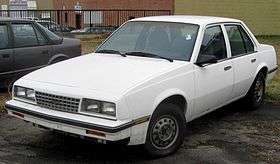 | |
| Overview | |
| Production |
1981–1994 1981-1987 (Coupe and Hatchback) |
| Model years |
1982–1994 1982-1987 (Coupe and Hatchback) |
| Assembly |
United States: Lordstown, Ohio (Lordstown Assembly) Lansing, Michigan (Lansing Car Assembly) Janesville, Wisconsin (Janesville GM Assembly Plant) South Gate, California (South Gate Assembly) Kansas City, Missouri (Leeds Assembly) Mexico: Ramos Arizpe, Coahuila (Ramos Arizpe Assembly) |
| Body and chassis | |
| Body style |
2-door convertible 2-door sedan 3-door hatchback 4-door sedan 4-door station wagon |
| Related |
Buick Skyhawk Cadillac Cimarron Oldsmobile Firenza Pontiac Sunbird Opel Ascona Vauxhall Cavalier Isuzu Aska Holden Camira |
| Powertrain | |
| Engine |
1.8 L L46 I4 (gasoline) 2.0 L LQ5 I4 (gasoline) 2.0 L LL8 I4 (gasoline) 2.8 L LB6 V6 (gasoline) |
| Transmission |
4-speed manual 5-speed manual 3-speed automatic |
| Dimensions | |
| Wheelbase | 101.2 in (2,570 mm) |
| Length |
Sedan: 174.5 in (4,432 mm) |
| Width |
Sedan & Coupe: 66.0 in (1,676 mm) Wagon: 66.3 in (1,684 mm) |
| Height |
Sedan & Coupe: 52.0 in (1,321 mm) Wagon: 54.2 in (1,377 mm) |


.jpg)

The Cavalier first went on sale in early 1981 as a 1982 model with front-wheel-drive, a choice of two carbureted versions of the GM 122 series four-cylinder pushrod engines, and 2 and 4-door sedan, hatchback, and station wagon body styles. Convertibles were added in 1983, initial production totaling less than 1000.
1983 Cavaliers offered throttle body fuel injection, and a V6 engine became available in 1985. The 1984 models received a mild facelift featuring quad headlights.
The Cavalier in Mexico was identical to the Pontiac Sunbird before the Pontiac brand was officially introduced there in 1992. After that time, the Cavaliers sold there featured Sunbird body panels, as opposed to US-spec Cavalier panels. From 1993 on, the sibling marques were both offered, much in the same way as in the United States.
Engines
- 1982: 1.8 L L46 carbureted OHV I4
- 1983-1986: 2.0 L LQ5 TBI OHV I4
- 1987–1989: 2.0 L LL8 TBI OHV I4
- 1985–1989: 2.8 L LB6 MPFI OHV V6
Second generation (1988–1994) Coupe version only
| Second generation | |
|---|---|
 | |
| Overview | |
| Production | 1987–1994 |
| Model years | 1988–1994 |
| Assembly |
Lordstown, Ohio, United States Lansing, Michigan, United States Ramos Arizpe, Coahuila, Mexico |
| Body and chassis | |
| Body style | 2-door coupe |
| Related |
Buick Skyhawk Cadillac Cimarron Oldsmobile Firenza Pontiac Sunbird Opel Ascona Vauxhall Cavalier |
| Powertrain | |
| Engine |
2.0 L LL8 I4 (gasoline) 2.2 L LM3 I4 (gasoline) 2.2 L LN2 I4 (gasoline) 2.8 L LB6 V6 (gasoline) 3.1 L LH0 V6 (gasoline) |
| Transmission |
5-speed manual 3-speed automatic |
| Dimensions | |
| Wheelbase |
1988–89: 101.2 in (2,570 mm) 1990–94: 101.3 in (2,573 mm) |
| Length |
1988–89: 178.6 in (4,536 mm) 1988–89 Wagon: 178.8 in (4,542 mm) 1990–94: 182.3 in (4,630 mm) 1990–94 Wagon: 181.1 in (4,600 mm) |
| Width |
66.3 in (1,684 mm) 1988–89 Sedan/Coupe/Wagon: 66.0 in (1,676 mm) |
| Height |
1988–1991 Coupe & 1990–91 Convertible: 52.0 in (1,321 mm) 1988–1991 Sedan: 53.6 in (1,361 mm) 1988–89 & 1992–95 Convertible: 52.2 in (1,326 mm) 1988–89 Wagon: 54.3 in (1,379 mm) 1990–91 Wagon: 54.1 in (1,374 mm) 1992–95 Wagon: 53.8 in (1,367 mm) 1992–95 Coupe: 51.9 in (1,318 mm) 1992–95 Sedan: 53.5 in (1,359 mm) |
| Curb weight |
2,359 lb (1,070 kg) (coupe) 2,363 lb (1,072 kg) (sedan) 2,271 lb (1,030 kg) (RS coupe) 2,414 lb (1,095 kg) (RS sedan) 2,558 lb (1,160 kg) (Z24 coupe) 2,665 lb (1,209 kg) (Z24 convertible) |
The Cavalier was restyled for 1988. The two door hatchback was dropped, while the coupe, sedan, wagon and convertible carried over. The sedan and wagon were unchanged from the doors back, while the coupe's exterior was completely redesigned. This resulted in different trunk designs for the coupe and sedan. Three trim levels were available in 1988: VL, RS, and Z24. The convertible was only available as a Z24. The VL and RS came standard with the 2.0 L OHV L4 engine, now upgraded to throttle-body injection, or TBI, producing 90 hp (67 kW), while the 2.8 L V6 producing 125 hp (93 kW) was optional on the RS and standard on the Z24.[1] With 2 door models, 5-speed manual transmission was standard, and a 3-speed automatic was optional, however the 3-speed automatic was made standard on sedans and wagons. An electronic dashboard was available with the RS and Z24 trims.
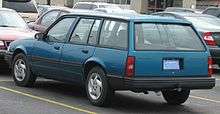
In 1989, the steering column was redesigned. The new self-aligning steering wheel was designed so as to reduce injuries in a collision by bending to conform to the driver's chest. Also, rear shoulder belts became standard on all models. RS and Z24 custom cloth seating received a new style of front bucket seats with integral headrests. The optional V6 was retooled to 130 hp.[2]
In 1990, the base engine was enlarged to a 2.2 L OHV L4, and power increased to 95 horsepower (71 kW). Door-mounted automatic front seatbelts were added due to US passive restraint legislation. The optional V6 engine was also upgraded to the 3.1 L V6 and 140 horsepower.[3] The convertible was dropped from availability to prevent internal competition with a planned Beretta convertible. However, the Beretta convertible was shelved at the eleventh hour, before a 1990 Cavalier convertible could be prepared.

The Cavalier got a more extensive restyling in 1991 that involved a new hood, bumpers, headlights, taillights, wheel covers and a redesigned interior, however with the body style remaining unchanged. Most notably, the cooling system was redesigned to draw air from the bumper, giving it a Ford Taurus-style bumper and grille-less nose. The new bumpers were unpainted, with the option to have them colored grey, black or white; the latter only available on white-colored models. The RS and the Z24 eschewed this for a color keyed body package. Z24 models also gained the options for a height adjustable driver's seat and a CD player. The platform and trim lines were carried over, while the convertible was brought back mid-year in the RS trim only with the V6 standard.[4]
Minor changes for 1991 also included the Alpha Tech ignition lock cylinder, which incorporated a dual-bit key that was larger and thicker in size in comparison to the old single-bit lock cylinder system that had been used for years. The lock system was intended to be a stronger deterrent to vehicle theft, but constant problems were reported with the lock jamming. It was dropped after an improved dual-bit single key system was introduced for the 1995 model year and redesign.
In 1992, the 2.2 L OHV standard engine adopted multi-point fuel injection, or MPFI to improve output to 110 horsepower (82 kW), however unlike the SFI version of the 2.2L in the Chevrolet Corsica.[5] The convertible was now available in both RS and Z24 trims, with the V6 standard in the Z24 and optional with the RS. Antilock brakes were added as a standard feature, as Delco Moraine had managed to develop a low-cost system. Power locks were also standard, and were designed to automatically lock when the car is shifted out of park, or if the car is traveling at least 8 miles per hour in manual transmission equipped Coupe models.
1993 brought minimal changes to the Cavalier line. The convertibles receive a glass rear window, allowing rear window defrost as an option.[6] Also, General Motors received a new grille for the final time in this generation of the Chevrolet Cavalier.

1994 models were also carryovers, as a redesign of the Cavalier was in development. The VL trim was dropped on the wagon, while the 2.2 L OHV L4 was now converted to the SFI version found in the Corsica, which delivered an output of 120 horsepower.[7] Additional changes included a slightly redesigned climate control interface and the power locking system being again redesigned: the doors would still lock automatically when put into gear, but they would also unlock automatically when the ignition was switched off.
Third generation (1995–2005)
| Third generation | |
|---|---|
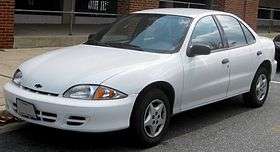 2000-2002 Cavalier sedan | |
| Overview | |
| Also called | Toyota Cavalier (Japan) |
| Production | 1995–2005 |
| Model years | 1994–2005 |
| Assembly |
Lordstown, Ohio, United States Lansing, Michigan, United States Ramos Arizpe, Coahuila, Mexico |
| Body and chassis | |
| Body style |
2-door convertible 2-door coupe 4-door sedan |
| Related | Pontiac Sunfire |
| Powertrain | |
| Engine | |
| Transmission |
3-speed 3T40 automatic 4-speed 4T40-E automatic 5-speed Getrag F23 manual 5-speed Getrag 282 manual 5-speed Isuzu manual |
| Dimensions | |
| Wheelbase | 104.1 in (2,644 mm) |
| Length |
1995–97: 180.3 in (4,580 mm) 1998–2002: 180.7 in (4,590 mm) 2003–05: 180.9 in (4,595 mm) |
| Width |
2-Door: 68.7 in (1,745 mm) 4-Door: 67.9 in (1,725 mm) |
| Height |
1995–97 Coupe: 53.2 in (1,351 mm) 1995–97 Sedan: 54.8 in (1,392 mm) 1995–97 Convertible: 53.9 in (1,369 mm) 1998–2005 Coupe: 53.0 in (1,346 mm) 1998–99 Convertible: 54.1 in (1,374 mm) 1998–2005 Sedan: 54.7 in (1,389 mm) 2000–02 Convertible: 53.7 in (1,364 mm) |
| Curb weight | 2,562–2,900 lb (1,162–1,315 kg) |
| Chronology | |
| Successor |
Chevrolet Cobalt (For United States and Canada) Chevrolet Optra (For Mexico) |
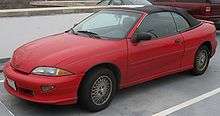
(Z24)
(RS and Base)

(RS and LS Sport)
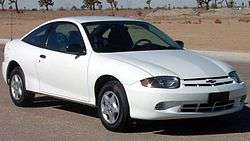
(Base, LS)
The Cavalier received its first total redesign in 1995, with expanded dimensions and more aerodynamic styling, taking minor design cues from the 4th Generation Chevrolet Camaro, its bigger brother. Some of the basic styling cues remained however, such as the bumper-integrated grille, the coupes' dipped beltline, and the charcoal-colored bumpers on some Base model cars. Coupe, sedan, and convertible options were offered, however the wagon model was replaced by an LS Sedan for the third generation which was equipped with power windows and power door locks. The car now had the available option of 15 and 16 inch wheels. By 1997, the Cavalier became the best selling car within the entire GM lineup.
All available engines were Inline-four engine. The option for a V6 engine, which had been available in the first and second generation, was dropped and replaced by a new four-cylinder of similar power output. Base and RS models still retained the 122 Pushrod four-cylinder engine (2.2 L OHV) of the previous models, which was primarily mated to a 3-speed automatic, but was available with 5-speed Manual in the two-door models, in particular the RS models. As of 1996 a new 4-speed automatic became available in any trim. The Z24 and LS convertible used the 2.3 L LD2 Quad-4 engine in 1995, but they received a new engine in 1996, the 2.4 liter DOHC LD9. This engine produced 150 hp (112 kW) and 155 lb·ft (210 N·m) of torque and was used until 2002. In 2000, the car gained a minor facelift consisting of bigger headlights and an improved grille, lost the "CHEVROLET" text badge at the trunklid and gained a new "CAVALIER" badge along with new "five spoke" hubcaps. The 2.4-litre engine came mated standard with the Getrag F23 5-speed manual transmission on the Z24 models, or with the optional 4-speed automatic on both the Z24 and the LS Models. The Z24 only came in two-door coupe models until 2001 and featured a sport-tuned suspension, 16-inch tires, alloy wheels and improved interior electronics. Aesthetically little changed from the other models other than a ground effects kit and taller rear spoiler. In 2000 a 4-door Z24 Sedan debuted, featuring the same mechanics but having a less sporty body. The Z24 trim also received several other upgrades including a wider front sway bar and FE2 Sports Suspension for better handling characteristics, and less aggressive ABS anti-lock braking system. In 2001, the 3-speed automatic was dropped from the base models equipped with the 2.2-L, and the 4-speed automatic became the main offering across the entire lineup, with 5-speed still available in the 2-door cars. Also, the RS was replaced by the LS Sport line, which featured the new Ecotec L61 motors (140 hp (104 kW) and 150 lb·ft (200 N·m) torque). These engines improved fuel economy, featuring the same displacement as the GM 122 Pushrod Engine (2.2 L OHV) while maintaining most of the power of the older LD9 motors. The new Ecotec motors replaced the GM 122 Pushrod Engine (2.2 L OHV) in base models in 2003, and became the sole engine choice in the entire Cavalier line-up until 2005 when the Chevrolet Cavalier was replaced by the Chevrolet Cobalt.
A GM Eaton M45 Supercharger kit was also offered for the Z24 trim as well. The supercharger kit was developed and tested by General Motors and could only be installed at a GM dealer. This upgrade increased performance considerably due to a pressure of 4.7 PSI which in turn added approximately 40 hp (30 kW) and 40 lb·ft (54 N·m) of torque increase; raising the Z24's ratings to approximately 190 hp (142 kW) and 195 lb·ft (264 N·m) of torque.
Facelifts
The third generation Cavalier had two facelifts: a minor one in 2000 and a major one in 2003. 2003's refresh included a new front end and a different rear lift gate design.
Safety
The third-generation Cavalier earned several low scores in crash tests by the Insurance Institute for Highway Safety and National Highway Traffic Safety Administration. Also, IIHS fatality risks statistics rated the Cavalier among the "Highest rates of driver deaths," with 150 (4 door) to 171 (2 door) driver deaths per million registered vehicle years. Average for the Cavalier class (small) was 103 (4 door) to 134 (2 door) driver deaths per million registered vehicle years.[8]
The IIHS gave the 1995-2005 Cavalier a "Poor" overall score in their frontal offset collision test.[9]
2005 National Highway Traffic Safety Administration (NHTSA) Crash Test Ratings (coupe):[10]
- Frontal Driver:





- Frontal Passenger:





- Side Driver:




 *safety concern*
*safety concern* - Side Rear Passenger:





- Rollover:





2002 National Highway Traffic Safety Administration (NHTSA) Crash Test Ratings (sedan):[11]
- Frontal Driver:





- Frontal Passenger:





- Side Driver:




 *safety concern*
*safety concern* - Side Rear Passenger:





- Rollover:





Toyota Cavalier

As part of a wider effort to avoid additional restrictions on exports to the US, the third generation model was briefly sold in Japan by Toyota under an agreement with GM, badged as the Toyota Cavalier.
Aside from the fact that it was right hand drive, the Toyota Cavalier also featured a leather-wrapped shift knob, steering wheel and park brake lever, wider front fenders, amber turn signals for Japanese regulations, power folding side mirrors, side turn signal repeater lights on the front fenders, and carpeting on the inside of the trunk lid. Interior seats were often flecked with color, and the rear seat had a fold-down armrest. Vehicles produced from February through December 1998 were available with a leather interior equipped with an automatic transmission only.
All models featured wheels borrowed from the Pontiac Sunfire. The Toyota Cavalier was available in 2.4G and 2.4Z trim levels. While all Chevrolet-badged Cavaliers received a facelift for 2000, the Toyota did as well with the updated center console, head-lights/hood/front bumper, tail-lights, and colors available. TRD made a body kit and rear wing for the Cavalier, available exclusively in Japan. The car was sold only at Toyota Store Japanese dealerships.
The Cavalier wasn't the only GM product sold in Japan; the Saturn S-series was sold in right hand drive conversions at Saturn dealerships (some former Isuzu dealerships) from 1996 until 2003, and some Toyota Vista Store also retailed Saturns.
The Toyota Cavalier was entirely produced by GM in the USA at the Lordstown Assembly location, and sold from 1995–2000. 1996-2000 Toyota Cavaliers came equipped with the 2.4 L LD9 engine, while the 1995 used the 2.3 L Quad 4. Due to the engine displacement and width dimensions (1,740 mm (69 in) for the coupe, 1,735 mm (68 in) for the sedan ) exceeding Japanese government regulations concerning exterior dimensions and maximum engine displacement, it was not considered a "compact" and incurred an additional annual tax, which had an effect on sales. Prices for the coupe started at ¥ 2 million yen for the coupe, and ¥ 1,81 million yen for the sedan. The engine displacement also contributed to added cost for Japanese buyers with a higher obligation when it was time to pay the annual road tax.
The introduction of the Toyota Cavalier was not the first time the Cavalier was sold in Japan. Yanase Co., Ltd., a Japanese retail dealership that started importing European and North American vehicles soon after the end of World War II, sold various GM products including the Cavalier. When the decision was made to sell the Cavalier as a Toyota, this disrupted operations at Yanase. When the Toyota Cavalier was cancelled, Yanase continued to sell Chevrolet and other GM products. Yanase also provides complete maintenance services for all vehicles sold.
Due to higher than typically average Motor-vehicle inspection (Japan) costs, a fair number of these vehicles are re-exported as Japanese used cars, most notably to Australia and New Zealand. Production of the Toyota Cavalier ceased in June 2000. Despite Toyota making considerable efforts to sell the Cavalier on the domestic market, the Japanese public perceived the quality of workmanship to not be up to the standard typically expected of locally built cars.[12] The car was also introduced while economic conditions in Japan were beginning to decline as a result of the collapse of the Japanese asset price bubble or "bubble economy" that ended in the early 1990s.
Fourth generation (2017-Present)
Chevrolet reintroduced the Cavalier name on a new China-only compact sedan below the Cruze. The Cavalier will be introduced at the 2016 Chengdu Auto Show on September 2, 2016. It's developed on the same platform as the first generation Cruze, the Delta II platform, and uses the 1.5 liter four-cylinder engine that powers many compact GM models in China, including the Chevrolet Sail. Its pricing sets the Cavalier exactly between the smaller Sail and the more modern second generation Cruze. Deliveries started in September, with almost 10,000 units sold in its first month, but there are indications the Cavalier cannibalizes sales of the similarly priced first generation Cruze, which is also still sold in China.[13]
Production
Most Cavaliers were built at Lordstown Assembly, although they have also been produced at South Gate Assembly (1982 model year only), Lansing Car Assembly (1996-1998 coupes), Lansing Craft Centre (1996-2000 convertibles), Janesville Assembly, Ramos Arizpe, and Leeds Assembly.
Production ended on October 6, 2005
United States sales figures
- 58,904 - 1982
- 268,587 - 1983
- 462,611 - 1984
- 383,752 - 1985
- 432,101 - 1986
- 346,254 - 1987
- 322,939 - 1988
- 376,626 - 1989
- 310,501 - 1990
- 326,847 - 1991
- 225,633 - 1992
- 251,590 - 1993
- 254,426 - 1994
- 151,669 - 1995
- 261,686 - 1996
- 315,136 - 1997
- 238,861 - 1998
Sources: Edmunds.com (1992–98), Autoworld.com (1999 estimate)[14]
Engines used
- 1982 — 1.8 L OHV 2-barrel inline-4, 88 horsepower
- mid 1982–1984 — 2.0 L OHV 2-barrel inline-4, 90 horsepower
- 1983–1989 — 2.0 L OHV TBI inline-4, 86 horsepower (1983–1984), 88 horsepower (1985–1986), 90 horsepower (1987–89)
- 1985–1989 — 2.8 L OHV MPFI V6, 120-130 horsepower (125 in 1985, 120 in 1986, 130 in 1987, 125 in 1988, and 130 in 1989)
- 1990–1994 — 2.8 L OHV MPFI V6, 130 horsepower (Mexico and Venezuela only, *Colombia used a version of 116 hp.
- 1990–1991 — 2.2 L OHV TBI inline-4, 95 horsepower (71 kW)
- 1990–1994 — 3.1 L OHV MPFI V6, 140 horsepower (100 kW)
- 1992–2002 — 2.2 L OHV MPFI L4, 110 horsepower (1992–93), 120 horsepower (1994–97, 1994 upgrade to SFI), 115 horsepower (1998–2002)
- 1995 — 2.3 L DOHC MPFI Quad 4, 150 horsepower (110 kW)
- 1996–2002 — 2.4 L DOHC SFI L4, 150 horsepower (110 kW)
- 2002–2005 — 2.2 L DOHC Ecotec SFI L4, 140 horsepower (100 kW)
References
- ↑ "''autos.msn - 1988 Chevrolet Cavalier''". Autos.msn.com. 2010-02-22. Retrieved 2010-10-05.
- ↑ the Auto Editors of Consumer Guide (2007-08-04). "''howstuffworks.com - 1989 Chevrolet Cavalier''". Auto.howstuffworks.com. Retrieved 2010-10-05.
- ↑ "''autos.msn - 1990 Chevrolet Cavalier''". Autos.msn.com. 2010-02-22. Retrieved 2010-10-05.
- ↑ "Chevy Cavalier History''". Conceptcarz.com. Retrieved 2010-10-05.
- ↑ "''autos.msn - 1992 Chevrolet Cavalier''". Autos.msn.com. 2010-02-22. Retrieved 2010-10-05.
- ↑ the Auto Editors of Consumer Guide (2007-08-04). "''howstuffworks.com - 1993 Chevrolet Cavalier''". Auto.howstuffworks.com. Retrieved 2010-10-05.
- ↑ "''autos.msn - 1994 Chevrolet Cavalier''". Autos.msn.com. 2010-02-22. Retrieved 2010-10-05.
- ↑ "Status Report, Vol. 42, No. 4, April 19, 2007" (PDF). Archived from the original (PDF) on 2008-11-27. Retrieved 2010-10-05.
- ↑ "IIHS-HLDI: Chevrolet Cavalier". Iihs.org. 2005-09-29. Retrieved 2010-05-13.
- ↑ "Safercar.gov". Safercar.gov. Retrieved 2010-05-13.
- ↑ "Safercar.gov". Safercar.gov. Retrieved 2010-05-13.
- ↑ http://www.thetruthaboutcars.com/2010/01/the-toyota-cavalier-and-the-truth-about-japanese-import-barriers/
- ↑ "New model introductions in China, September 2016". Left-Lane.com. 2016-10-15. Retrieved 2015-10-16.
- ↑ Osborn. "Chevrolet Cavalier Z24 - Two Times the Fun". Autoworld.com. Archived from the original on February 14, 2006. Retrieved July 21, 2006.
External links
| Wikimedia Commons has media related to Chevrolet Cavalier. |
| « previous — Chevrolet, a marque of General Motors, road car timeline, United States market, 1980s–present | ||||||||||||||||||||||||||||||||||||||
|---|---|---|---|---|---|---|---|---|---|---|---|---|---|---|---|---|---|---|---|---|---|---|---|---|---|---|---|---|---|---|---|---|---|---|---|---|---|---|
| Type | 1980s | 1990s | 2000s | 2010s | ||||||||||||||||||||||||||||||||||
| 0 | 1 | 2 | 3 | 4 | 5 | 6 | 7 | 8 | 9 | 0 | 1 | 2 | 3 | 4 | 5 | 6 | 7 | 8 | 9 | 0 | 1 | 2 | 3 | 4 | 5 | 6 | 7 | 8 | 9 | 0 | 1 | 2 | 3 | 4 | 5 | 6 | 7 | |
| Subcompact | Sprint | Geo | Metro | Spark | Spark | |||||||||||||||||||||||||||||||||
| Chevette | Aveo | Sonic | ||||||||||||||||||||||||||||||||||||
| Spectrum | Bolt | |||||||||||||||||||||||||||||||||||||
| Monza | Nova | |||||||||||||||||||||||||||||||||||||
| Compact | Prizm | Volt | Volt | |||||||||||||||||||||||||||||||||||
| Cavalier | Cavalier | Cavalier | HHR | |||||||||||||||||||||||||||||||||||
| Citation | Corsica / Beretta | Cobalt | Cruze | Cruze | ||||||||||||||||||||||||||||||||||
| Mid-size | Malibu | Malibu | Malibu | Malibu | Malibu | Malibu | ||||||||||||||||||||||||||||||||
| Celebrity | Lumina | Lumina | ||||||||||||||||||||||||||||||||||||
| Full-size | Impala | Impala SS | Impala | Impala | Impala | |||||||||||||||||||||||||||||||||
| SS | ||||||||||||||||||||||||||||||||||||||
| Caprice | Caprice | Caprice | ||||||||||||||||||||||||||||||||||||
| Personal | Monte Carlo | Monte Carlo | Monte Carlo | Monte Carlo | ||||||||||||||||||||||||||||||||||
| Sports car | Camaro | Camaro | Camaro | Camaro | Camaro | |||||||||||||||||||||||||||||||||
| Corvette | Corvette | Corvette | Corvette | Corvette | ||||||||||||||||||||||||||||||||||
| Blue denotes vehicles which are available exclusively to police departments. | ||||||||||||||||||||||||||||||||||||||